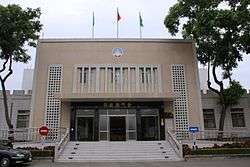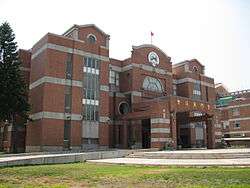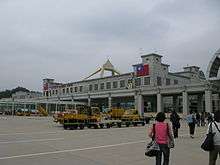Kinmen
Kinmen or Quemoy (/kɪˈmɔɪ/; Mandarin pinyin: Jīnmén; Hokkien POJ: Kim-mn̂g (locally) or Kim-mûi), officially Kinmen County,[2][3] is an insular county in the Republic of China (Taiwan) located just off the southeastern coast of mainland China. The county consists of the Kinmen Islands (including Great Kinmen and Lesser Kinmen) and the Wuqiu Islands (Ockseu) more than 110 kilometres (68 mi) to the northeast. It is one of two counties under the streamlined Fujian Province of the Republic of China. The Kinmen Islands are located only about two kilometres (1.2 mi) east of the mainland city of Xiamen (Amoy), and their strategic position has reflected the significant change of Cross-Strait relations from a battlefront to a trading point between mainland China and Taiwan. In the controversy regarding the political status of Taiwan, the People's Republic of China (PRC) has continuously claimed the territory of Kinmen County as part of its own Fujian Province, claiming the Kinmen Islands as a county of Quanzhou prefecture-level city,[4][5][6][7] and claiming the Wuqiu (Ockseu) Islands as part of Xiuyu District in Putian prefecture-level city,[8] whereas Taiwan (Republic of China) claims the Dadeng (Tateng) Islands in Dadeng Subdistrict, Xiang'an District, Xiamen, Fujian as part of Kinmen County.[1][9][10]
Kinmen County 金門縣 Quemoy, Kimoi, Chinmen, Chin-men | |
|---|---|
County | |
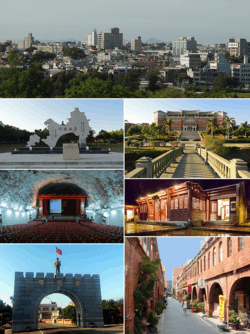 | |
 Flag  Logo | |
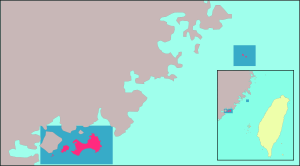 | |
| Coordinates: 24°26′N 118°20′E | |
| Country | Republic of China |
| Province | Fujian |
| Seat | Jincheng |
| Largest city | Jincheng |
| Townships Villages | 6 (3 urban, 3 rural) 37 (24 urban, 13 rural) |
| Government | |
| • County Magistrate | Yang Cheng-wu (KMT) |
| Area | |
| • Total | 153.011 km2 (59.078 sq mi) |
| Area rank | 20 of 22 |
| Population (December 2014) | |
| • Total | 127,723 |
| • Rank | 20 of 22 |
| • Density | 830/km2 (2,200/sq mi) |
| Time zone | UTC+8 (National Standard Time) |
| ISO 3166 code | TW-KIN |
| Website | www.kinmen.gov.tw/ |
| Symbols | |
| Bird | Hoopoe |
| Flower | Four-season orchid |
| Tree | Cotton tree |
| Kinmen (Quemoy) | |||||||||||||||||||||||||||||||||||
|---|---|---|---|---|---|---|---|---|---|---|---|---|---|---|---|---|---|---|---|---|---|---|---|---|---|---|---|---|---|---|---|---|---|---|---|
| Traditional Chinese | 金門 | ||||||||||||||||||||||||||||||||||
| Postal | Kimoi, Kinmen | ||||||||||||||||||||||||||||||||||
| |||||||||||||||||||||||||||||||||||
| Kinmen County | |||||||||||||||||||||||||||||||||||
| Traditional Chinese | 金門縣 | ||||||||||||||||||||||||||||||||||
| |||||||||||||||||||||||||||||||||||
Names
Kinmen was given its name (金門; Jīnmén; 'golden gate') in 1387 when the Hongwu Emperor of China's Ming dynasty appointed a military officer, Zhou Dexing (周德興), to administer the island and protect it from wokou (pirate) attacks.[11] The name is pronounced Jīnmén in Mandarin Chinese but some of the various names used in English for the islands derive from other Chinese varieties.
Quemoy is the name for the island in English and in many European languages.[12] It likely began as a Spanish or Portuguese transcription of the Zhangzhou Hokkien pronunciation of the name, Kim-mûi.[13] This form of the islands' name was used almost exclusively in English until the late 20th century and is used widely in English-language contexts that involve historical coverage. For example, works that deal with the First and Second Taiwan Strait Crises (the Quemoy Incident[14]) and the 1960 U.S. presidential election debates when the islands received prominent worldwide news coverage all use the word Quemoy. In addition, the former National Kinmen Institute of Technology was renamed National Quemoy University in 2010. Kinmen scholar Wei Jian-feng advocates the use of the word Quemoy to better connect the island to "international society or achieve more recognition in the world".[13]
Kinmen is a more recent Mandarin Chinese transcription from the postal romanization system. With some exceptions, this form is used in most current English-language contexts on Kinmen and in Taiwan as a whole. Entities such as the county government,[15] the islands' airport,[16] and the national park[17] use this spelling.
Kimoi is a Hokkien-derived spelling also used in the postal romanization system.[18][19]
Chin-men is the Mandarin Chinese Wade–Giles-derived romanization form of the island's name and appears on maps using that as their standard.[20]
Jinmen is the Mandarin Chinese Tongyong Pinyin-derived and Hanyu Pinyin-derived form of the island's name used especially in sources from the People's Republic of China.[21][22]
History
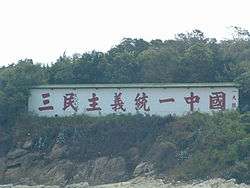
Tang Dynasty
People began settling down in Kinmen during the Tang Dynasty, changing the original name from Wuzhou to Kinmen.[23]
Ming Dynasty
During the Ming Dynasty, more migrants came to settle down in Kinmen. Koxinga used Kinmen as a base to liberate Kinmen and Penghu from the Dutch. He cut down trees to build his navy, resulting in massive deforestation that made Kinmen vulnerable to soil erosion.[23]
Qing Dynasty
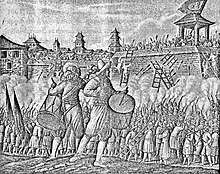
The Prince of Lu, a member of the Southern Ming Dynasty, resisted the invading Manchu Qing Dynasty forces. In 1651, he fled to Kinmen, which the Qing dynasty took in 1663.[24] During the Qing Dynasty, the Kinmen area was part of Tungan County.[2][25]
Republic of China
After the establishment of the Republic of China (ROC) in 1912, Kinmen became part of Fujian Province. In 1913, the Kinmen area was made part of Siming County.[25] Kinmen County was established in 1914.[25][6] In 1928, the county came under direct administration of the provincial government.[25]
Japan occupied Kinmen County during the Second Sino-Japanese War from 1937 to 1945. During this period, the county government was moved to Dadeng.[2]
After the establishment of the People's Republic of China (PRC) in October 1949, Kinmen County was claimed by both the ROC and PRC. Dadeng, Xiaodeng and Jiaoyu were taken by the PRC on October 9[6] or October 15,[26] 1949. The islands are claimed by the ROC.[27] They are part of Dadeng Subdistrict, Xiang'an District, Xiamen, Fujian, China.[28][29]
On October 25, 1949, PLA forces landed on Greater Kinmen near Guningtou beginning the Battle of Kuningtou. ROC forces successfully defended the island and prevented an attack on Taiwan.
At the outbreak of the Korean War in 1950, retired Admiral Charles M. Cooke Jr., advisor to President Chiang Kai-shek, opposed withdrawing ROC forces from Quemoy (Kinmen).[30] On July 26, 1950, ROC forces on Dadan Island (Tatan), in total 298 soldiers, repulsed an attack (大擔島戰役) from a People's Liberation Army force of 700 soldiers that landed on the island.[31]:11, 19–20 General Douglas MacArthur and other US officials supported ROC efforts to defend the islands.[32]

The People's Liberation Army extensively shelled the island during the First and Second Taiwan Strait crises in 1954–1955 and 1958 respectively. In 1954, the United States considered responding by using nuclear weapons against the PRC.[33] Again in 1958, General Nathan Farragut Twining and the Joint Chiefs of Staff believed that the United States should not permit the loss of the islands to the communists and recommended to President Eisenhower the use of whatever force was necessary, including atomic weapons.[34]
The phrase "Quemoy and Matsu" became part of American political language in the 1960 U.S. presidential election. During the debates, both candidates, Vice-President Richard Nixon and Senator John F. Kennedy, pledged to use American forces if necessary to protect Taiwan from invasion by the PRC, which the United States did not recognize as a legitimate government. But in the second debate on October 7, 1960, the two candidates presented different opinions about whether to use American forces to protect Taiwan's forward positions, Quemoy and Matsu, also. Senator Kennedy stated that these islands - as little as 9 kilometres (5.5 mi) off the coast of China and as much as 170 kilometres (106 mi) from Taiwan - were strategically indefensible and were not essential to the defense of Taiwan. Vice-President Nixon maintained that since Quemoy and Matsu were in the "area of freedom," they should not be surrendered to the Communists as a matter of principle.[35]
Earlier in the debate, then-Vice President Nixon mentioned:
In the Truman Administration 600 million people went behind the Iron Curtain including the satellite countries of Eastern Europe and Communist China. In this Administration we have stopped them at Quemoy and Matsu, we have stopped them in Indo China, we have stopped them in Lebanon, we have stopped them in other parts of the world.
Later in the debate, Edward P. Morgan asked then-Senator Kennedy:[36][37]
Senator, Saturday on television, you said that you had always thought that Quemoy and Matsu were unwise places to draw our defense line in the Far East. Would you comment further on that, and also address to this question: couldn't a pull-back from those islands be interpreted as appeasement?
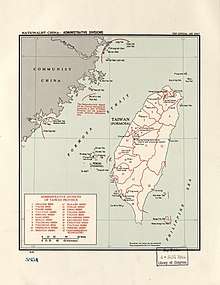
"The Nationalist-held islands off the Chinese mainland are nominally a part of Fukien Province, but are presently under military administration." (1962)
Then-Senator Kennedy responded to Morgan's question saying:
Well, the United States has on occasion attempted, mostly in the middle '50s to persuade Chiang Kai-shek to pull his troops back to Formosa. I believe strongly in the defense of Formosa. These islands are a few miles, five or six miles[lower-alpha 2] off the coast of Red China within a general harbor area, and more than a hundred miles[lower-alpha 3] from Formosa. We have never said flatly that we will defend Quemoy and Matsu if it is attacked. We say we will defend it if it's part of a general attack on Formosa, but it is extremely difficult to make that judgment.
Now, Mr. Herter, in 1958, when he was Under Secretary of State, said they were strategically indefensible. Admiral Spruance and Collins in 1955 said that we should not attempt to defend these islands in their conference on the Far East. General Ridgway has said the same thing. I believe that when you get into a war, if you're going to get into a war for the defense of Formosa, it ought to be on a clearly defined line. One of the problems, I think, at the time of South Korea was the question of whether the United States would defend it if it were attacked. I believe that we should defend Formosa, we should come to its defense. It leaves this rather in the air that we will defend it under some conditions but not under others, I think it is a mistake.
Secondly, I would not suggest a withdrawal at the point of the Communist guns. It is a decision finally that the Nationalists should make and I believe that we should consult with them and attempt to work out a plan by which the line is drawn at the Island of Formosa. It leaves 100 miles[lower-alpha 4] between the sea. But with General Ridgway, Mr. Herter, General Collins, Admiral Spruance and many others, I think it is unwise to take the chance of being dragged into a war which may lead to a world war over two islands which are not strategically defensible, which are not according to their testimony, essential to the defense of Formosa.
I think that we should protect our commitments. I believe strongly we should do so in Berlin. I believe strongly we should do so in Formosa and I believe we should meet our commitments to every country whose security we've guaranteed. But I do not believe that that line, in case of a war, should be drawn on those islands, but instead on the island of Formosa. And as long as they are not essential to the defense of Formosa, it has been my judgement ever since 1954, at the time of the Eisenhower Doctrine for the Far East, that our line should be drawn in the sea around the island itself.
Then-Vice President Nixon retorted:
I disagree completely with Senator Kennedy on this point.
I remember in the period immediately before the Korean War, South Korea was supposed to be indefensible as well. Generals testified to that, and Secretary Acheson made a very famous speech at the Press Club early in the year that the Korean War started, indicating in effect that South Korea was beyond the defense zone of the United States. I suppose it was hoped when he made that speech that we wouldn't get into a war, but it didn't mean that. We had to go in when they came in.
Now I think as far as Quemoy and Matsu are concerned, that the question is not these two little pieces of real estate- they are unimportant. It isn't the few people who live on them- they are not too important. It's the principle involved. These two islands are in the area of freedom. The Nationalists have these two islands. We should not force our Nationalist allies to get off of them and give them to the Communists. If we do that, we start a chain reaction, because the Communists aren't after Quemoy and Matsu, they're after Formosa. In my opinion, this is the same kind of woolly thinking that lead to disaster for America in Korea, I'm against it, I would never tolerate it as President of the United States, and I will hope that Senator Kennedy will change his mind if he should be elected.
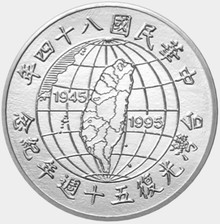
After the third debate on October 13, 1960, Kennedy's advisers spoke with then Secretary of State Herter and said Kennedy was willing to revise his position on the Quemoy and Matsu issue so as not to give the Communists the impression that the USA would not stand united against aggression. Nixon pointed out the change in Kennedy's position but decided not to press the point due to the importance of the USA's role in what was an extremely tense situation.[38] Nixon's polls among Republicans and Democrats showed overwhelming support for Nixon's position on the issue.[39]
Kinmen was originally a military reserve, which eventually led to the 1987 Lieyu massacre.[40] The island was returned to the civilian government in the mid-1990s, after which travel to and from it was allowed. Direct travel between mainland China and Kinmen re-opened in January 2001 under the mini Three Links, and there has been extensive tourism development on the island in anticipation of mainland tourists.[41] Direct travel was suspended in 2003 as a result of the SARS outbreak, but has since resumed.[42]
Many Taiwanese businessmen use the link through Kinmen to enter the Chinese mainland, seeing it as cheaper and easier than entering through Hong Kong. However, this changed following the 2005 Pan-Blue visits to mainland China and the 2008 presidential and legislative victories of the KMT, that allowed easier Cross-Strait relations. Kinmen has experienced a considerable economic boom as businessmen relocate to the island for easier access to the vast markets of the PRC.
On 30 June 2014, Dadan Island and Erdan Island were handed over from the military to civilians, represented by Kinmen County Government.[43] Since 1 January 2015, tourists from Mainland China could directly apply for the Exit and Entry Permit upon arrival in Kinmen. This privilege also applies to Penghu and Matsu Islands as means to boost tourism in the outlying islands of Taiwan.[44]
On August 23, 2019, the sixty-first anniversary of the beginning of the Second Taiwan Strait Crisis, President Tsai Ing-wen visited the Taiwushan Martyrs' Shrine (太武山忠烈祠) where she placed flowers and offered incense.[45]
Geography
The county is made up of numerous islands and islets[46][47][25][10] including:
- Kinmen group[48]
- Kinmen (Kinmen, Main island; 大金門, 金門本島) (main island; divided into four townships)
- Dongding Island (Tangtia, Tungting 東碇島, 東椗島) (in Jinhu Township; approximately 35 km (22 mi) to the southwest)
- Beiding Island (北碇島) (in Jinhu Township; approximately 4 km (2.5 mi) to the east)
- Cao Islet (Ts'ao Hsü; 草嶼) (in Jinsha Township) 24.523335°N 118.437021°E
- Hou Islet (后嶼) (in Jinsha Township) 24.529171°N 118.41233°E
- Jiangong Islet (建功嶼) (in Jincheng Township)
- Lesser Kinmen (Hsiao Kinmen, Lieyu; 小金門, 烈嶼) (second largest island under ROC control; in Lieyu Township)
- Dadan Island (大膽島) (in Lieyu Township)
- Erdan Island (二膽島) (in Lieyu Township)
- Fuxing Islet (Fuhsing Islet; Phaktia) (復興嶼) (in Lieyu Township)
- Menghu Islet (Tiger Island, 猛虎嶼) (in Lieyu Township)
- Shi Islet (Lion Islet) (獅嶼) (in Lieyu Township)
- Binlang Islet (檳榔嶼) (in Lieyu Township)
- Dadeng (Tateng[49][50][51]) (大嶝[27][1][52]/大嶝島[26]) (under PRC control from October 9[6] or October 15, 1949;[26] part of Dadeng Subdistrict, Xiang'an District, Xiamen, Fujian[28][29])
- Xiaodeng (Hsiaoteng,[51] Siao Deng[53]) (小嶝[27][1][52]/小嶝島[26]) (under PRC control from October 9[6] or October 15, 1949;[26] part of Dadeng Subdistrict, Xiang'an District, Xiamen, Fujian[28][29])
- Jiaoyu[54]/Jiao Yu[55] (Chiao I.,[56] 角嶼[27][1][52][26]) (under PRC control from October 9[6] or October 15, 1949;[26] part of Dadeng Subdistrict, Xiang'an District, Xiamen, Fujian[28][29])
- Wuqiu (Ockseu, Wuchiu; 烏坵) group
- Daqiu (Tachiu, Taciou; 大坵) (in Wuqiu Township)
- Xiaoqiu (Hsiaochiu; 小坵) (in Wuqiu Township)
Demographics
| Year | Pop. | ±% |
|---|---|---|
| 1985 | 48,846 | — |
| 1990 | 42,754 | −12.5% |
| 1995 | 47,394 | +10.9% |
| 2000 | 53,832 | +13.6% |
| 2005 | 76,491 | +42.1% |
| 2010 | 97,364 | +27.3% |
| 2015 | 132,799 | +36.4% |
| Source:"Populations by city and country in Taiwan". Ministry of the Interior Population Census. | ||
Culture
The people of Kinmen see themselves as Kinmenese, Mínnánrén/Mǐnnánrén (people of Southern Fujian), or Chinese, but not so much as Taiwanese.[14][57] The strong Chinese identity was forged during the period of the ROC's military confrontation with the People's Republic of China (1949–1992) when Kinmen was under military administration.[14] In the 1980s, as the militarization decreased and martial law was ended on Taiwan, the Taiwan independence movement and efforts in de-Sinicization grew in strength on Taiwan.[14] To Kinmenese, however, these developments were viewed with concern and there was a feeling that "Taiwan didn't identify with Kinmen".[14] Many worried that Taiwanese de jure independence from China would lead to the severing of ties with Kinmen.[14] These concerns play a strong role in Kinmenese politics as well.[14]
Language
Many of the county's inhabitants speak Hokkien; the Quanzhou accent is predominant. Most residents will say they speak Kinmenese, which is mutually intelligible with Taiwanese Hokkien. The residents of Wuchiu Township speak Pu-Xian Min, as opposed to Hokkien for the rest of Kinmen.
Others
Kinmen is notable for a number of cultural products. Due to the extensive shelling by the People's Liberation Army in the 1950s, Kinmen is famous for its artillery shell knives. Local artisans would collect the vast amounts of exploded ordnance and make high-quality knives which are still sought after by chefs and connoisseurs. Kinmen is also home of the regionally famous Kinmen Kaoliang liquor, a spirit ranging between 38 and 63 percent alcohol, which is highly appreciated by the Taiwanese. Other local culinary specialties include Kinmen noodles, kòng-thn̂g and beef jerky (bakkwa).
Like the Ryukyus, Kinmen is known for shisa (wind-lion god) figures (風獅爺).[58]
Economy
Kinmen's economy is mainly based on tourism and services due to its proximity to mainland China.[59][60]
Tourism
Because of its military importance, development on the island was extremely limited. Only by 2003, Kinmen opened up itself to tourists from Fujian in Mainland China.[61] It is now a popular weekend tourist destination for Taiwanese and is known for its quiet villages, old-style architecture and beaches. Chinese and Taiwanese tour groups also spend a short time touring the island whilst transiting between the ferry and the airport, as an intermediate stop between China and Taiwan. Large parts of Kinmen form the Kinmen National Park which highlights military fortifications and structures, historical dwellings and natural scenery.
The year 2014 recorded the highest number of passengers traveling by ferry between Kinmen and Fujian ports for as many as 1.5 million people.[62] Since 1 January 2015, Chinese mainland tourists were no longer be required to apply for Exit and Entry Permit in advance for visits to Kinmen, Penghu and Matsu Islands. Instead, they can apply for it upon arrival at a cost of NT$600.[63]
By 2016, two infrastructure projects are expected to boost tourism and meetings, incentives, conferencing, exhibitions visitors to the islands. One includes a yet-to-be-named five-star resort spearheaded by Xiamen property developer, Wu Youhua, president of Xiamen Huatian Group, the first time a Chinese interest has been allowed to invest in the Taiwan hotel sector.[64]
Tourist attractions
Tourist-related affairs in Kinmen are governed by Transportation and Tourism Bureau of Kinmen County Government. Major tourist attractions in Kinmen are:[25]
Museums
August 23 Artillery Battle Museum, Guningtou Battle Museum, Hujingtou Battle Museum, Yu Da Wei Xian Sheng Memorial Museum.
Historical buildings
Deyue Gun Tower, Gulongtou Zhenwei Residence, Zhaishan Tunnel, Juguang Tower, Kinmen Folk Culture Village, Kinmen Military Headquarters of Qing Dynasty, Mashan Broadcasting and Observation Station, Mofan Street and Wuqiu Lighthouse.
Religious buildings
Industry
Kinmen is famous for the production of Kaoliang wine, which takes up about 75% of Taiwan's market share, in which it is a strong economic backbone of the county. Traditional industries are also being kept and improved, ranging from agriculture, fishery and livestock. It has a good fishery industry also due to its nature being surrounded by unpolluted sea.
Kinmen also produces its unique Kinmen knife, in which the raw material used to produce it is taken from the remaining of shells fired by the People's Liberation Army in 1958-1978. The knife was made as gift to the visiting Head of Taiwan Affairs Office Zhang Zhijun to Kinmen on 23–24 May 2015 to symbolize mutual peace between the two sides of the Taiwan Strait and to bury the hatchet left from Chinese Civil War.[65][66]
Imported goods
Kinmen often import more goods from Mainland China than Taiwan Island because of lower costs due to the proximity of the county to the mainland. During the campaign for the 2014 county magistrate, all of the magistrate candidates spent their money on campaign materials produced in mainland provinces, such as Guangdong, Zhejiang and Fujian instead of from Taiwan Island.[67]
Politics
.jpg)
The island consistently votes for the Kuomintang (KMT). Until the early 1990s, proponents of Taiwan independence argued that they would consider handing Kinmen over to the PRC in any negotiated settlement. Residents of the island have broadly opposed such measures, fearing the consequences of the PRC government's policies on their standard of living and political freedom.
The Democratic Progressive Party has a minor presence on the island and typically does not present candidates to stand in local elections, although it does hold a single seat in Kinmen County Council from both of the 2009 and 2014 local elections. However, the party occasionally lends support to liberal or center-left candidates.
On 29 November 2014 however, independent candidate Chen Fu-hai won the county magistrate election and took office as the Magistrate of Kinmen County on 25 December 2014, the first independent candidate to win the office. He replaced Magistrate Lee Wo-shih of the Kuomintang.[68] The 2014 Kinmen County magistrate election consisted of 10 candidates, the highest number of nominated candidates in the electoral history of Taiwan.[69]
Kinmen County Constituency is represented by a single seat in the Legislative Yuan. The incumbent Magistrate of Kinmen County is Yang Cheng-wu of the Kuomintang.[70]
Townships
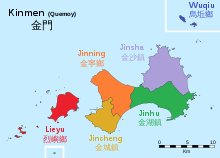
Kinmen County is divided into 3 urban townships and 3 rural townships.[71] Jincheng Township is the county seat which houses Kinmen County Government and Kinmen County Council. The township also houses the headquarter office of Kinmen-Matsu Joint Services Center. Kinmen County has the fewest rural townships among other counties in Taiwan.
| Name | Chinese | Hanyu Pinyin | Wade–Giles | Hokkien Pe̍h-ōe-jī | English meaning |
|---|---|---|---|---|---|
| Urban townships | |||||
| Jincheng Township | 金城鎮 | Jīnchéng Zhèn | Chin¹-ch'eng² Chen⁴ | Kim-siâⁿ-tìn | 'Golden City' |
| Jinhu Township | 金湖鎮 | Jīnhú Zhèn | Chin¹-hu² Chen⁴ | Kim-ô͘-tìn | 'Golden Lake' |
| Jinsha Township | 金沙鎮 | Jīnshā Zhèn | Chin¹-sha¹ Chen⁴ | Kim-soa-tìn | 'Gold Dust'[72] |
| Rural townships | |||||
| Jinning Township | 金寧鄉 | Jīnníng Xiāng | Chin¹-ning² Hsiang¹ | Kim-lêng-hiong | 'Golden Tranquility' |
| Lieyu Township | 烈嶼鄉 | Lièyǔ Xiāng | Lie⁴-yü³ Hsiang¹ | Lia̍t-sū-hiong | 'Split-off Islet'[73] |
| Wuqiu Township | 烏坵鄉 | Wūqiū Xiāng | Wu¹-ch'iu¹ Hsiang¹ | O͘-khiu-hiong | 'Black Mound' |
All those townships on Greater Kinmen Island start their names with Jin (i.e., Kin, lit. "gold"). Lieyu Township encompasses the entire Lesser Kinmen Island, and is the closest to Xiamen. Wuqiu Township comprises Greater Qiu Islet (大坵) and Lesser Qiu Islet (小坵).
Jincheng and Jinsha are the largest of the six townships. Altogether, there are 37 villages in Kinmen County.
Education
In August 2010, National Quemoy University was established from the predecessor National Kinmen Institute of Technology and Kinmen Division of National Kaohsiung University of Applied Sciences established in 1997.[74] It is located in Jinning Township. The islands also have a satellite campuses of Ming Chuan University and National University of Kaohsiung. Secondary educational institutions include National Kinmen Senior High School and National Kinmen Agricultural and Industrial Vocational Senior High School. In total, there are 24 junior high schools, elementary schools and kindergartens.[75]
The Kinmen County Government have invested millions in education in Kinmen, with an average of NT$20,000 per student. Schools in the county also accept the growing number of Taiwanese students whose parents are doing business in Fujian.[76] The county government has been striving to encourage universities in Taiwan Island and Mainland China to set up branches in the county, as well as to attract Chinese mainland students to study in Kinmen.[77]
Infrastructure
Electricity
The Kinmen Power Company was founded in 1967 and gradually built five power plants in the county and is in charge of providing power resources to all residents in Kinmen. It used to rely on light diesel oil which created high cost burden to its management. Since 1992, the ROC central government approved the power company to authorize Taiwan Power Company (Taipower) for five-year management. All of the power development projects were invested by Taipower and helped the region economic development. In July 1997, Kinmen Power Company was officially incorporated to Taipower. In 1999, the diesel-fired Tashan Power Plant was built to supply electricity to Kinmen grid. The other smaller power plants were subsequently discontinued to reduce cost.[75]
Submarine telecommunication cable
In August 2012, Kinmen and Xiamen established the first submarine telecommunication cable between the two sides. On Taiwan side, the infrastructure was constructed by Chunghwa Telecom, while on mainland China's side was done by China Telecom, China Unicom and China Mobile. The project was initially launched in 1996 and took 16 years to build.[78]
The telecommunication system consists of two cables, one is a 11 km (6.8 mi) long cable that runs from Kinmen's Lake Tzu and Xiamen's Mount Guanyin, and the other is a 9.7 km (6.0 mi) long cable that runs from Guningtou on Greater Kinmen Island (ROC) to Dadeng Island (PRC). The system is a non-repeater system with a bilateral transmission capacity of 90 Gbit/s, which might be expanded in the future if demand arises.[78]
Water supply
The current daily water demand for Kinmen is 50,000 tonnes, which are used for households, industries and agriculture sectors. One tonne of water produced for Kinmen costs about NT$50–60 and may surge to NT$70 during summer. In extreme drought condition, water shipment from Taiwan Island may cost as much as NT$200 per tonne. Because Kinmen residents pay only NT$10 for each tonne water they use, the cost of water supply has become a heavy burden for the county government.[79]
For decades, Kinmen has been facing difficulties in water supply to its residence due to its shallow lakes, lack of rainfall and geographical constraints which makes building reservoirs and dams unfeasible. Therefore, Kinmen often overuses its groundwater, causing rising tidal flood and soil salinity.
In early September 2013, the People's Republic of China government agreed to supply Kinmen with water from Jinjiang City in Fujian due to the ongoing water shortage problem in Kinmen. Kinmen draws more than 8,000 tonnes of groundwater every day and water from its reservoir is barely enough to support the residents during the dry season. The shortage problem will heavily hit the local economy by 2016 if no mitigation plan is enacted. The water supply agreement was officially signed on 20 July 2015 in Kinmen between Kinmen County Waterworks Director Weng Wen-kuei (翁文貴) and Fujian Water Supply Co chairman Zhu Jinliang (朱金良) witnessed by Kinmen County Magistrate Chen Fu-hai and Fujian Province Governor Su Shulin.[80]
The water pipeline was officially opened on 5 August 2018 when the first water supply was delivered in a ceremony held in both Kinmen County and Jinjiang City in Mainland China.[81]
Transportation
Air
Kinmen is served by Kinmen Airport, a domestic airport located at Jinhu Township, connecting Kinmen with Magong Airport, Penghu and Taipei Songshan, Kaohsiung, Taichung, Chiayi and Tainan Airport on Taiwan Island.
Sea
People coming from Mainland China can also visit Kinmen using ferry via Fujian from Xiamen at Wutong Ferry Terminal or from Quanzhou arriving at Shuitou Pier in Jincheng Township.[82] Kinmen to Xiamen Ferry, is a popular route between the Chinese Mainland and Taiwanese tourists alike, with brisk connections available between the ferry ports and Kinmen Airport (for Taiwanese destinations) and Xiamen's Airport and Xiamen North Railway Station (for Mainland destinations). The Kinmen-Quanzhou Ferry is only available to local travellers and foreigner passport holders are not permitted to use this service.
A new commercial port has been built adjacent to the Shuitou Pier on newly reclaimed land. This will handle the majority of sea freight to and from Kinmen. Previously most of this traffic was handled by a smaller port on the South-East corner of the island in Jinhu Township. In the past, due to constant artillery shelling from the Chinese mainland, an underground port was used to supply the island in times of conflict at the Jhaishan Tunnels on the South-Western tip of the island but this has been decommissioned and turned into a tourist attraction.
Greatly used as a transit route between the Chinese Mainland and Taiwan Island, buses also connect to the ferry terminal to allow for quick transfer to the Xiamen.
Road
A 5.4 km (3.4 mi) bridge, Kinmen Bridge, connecting Kinmen Island (Greater Kinmen) and Lieyu is planned to be completed by 2020, estimated to cost NT$7.5 billion (US$250 million).[83] It is expected to increase local tourism; the bridge's 1.4 km (0.87 mi) main body will have the largest span in the world when completed.[84]
In October 2019, Mainland China announced a plan to build a bridge linking Xiamen to Kinmen. Taiwan's Mainland Affairs Council (MAC) said that the plans were made unilaterally by China as part of its schemes to absorb Taiwan and divide Taiwanese society and that they see no need for bridges linking either Matsu or Kinmen to China.[85]
Gallery
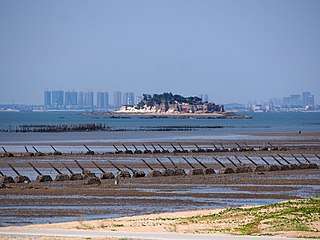
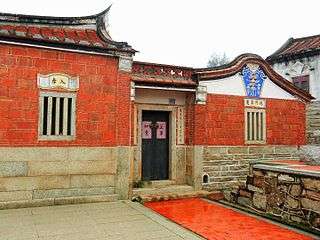 Shuitou historical residence (水頭古厝)
Shuitou historical residence (水頭古厝)- Daitianfu (代天府) in Jincheng
See also
Notes
- Area figure excludes the Dadeng (Tateng) Islands.
- The northern coast of Greater Kinmen (Quemoy) is about five or six miles from the nearest point on mainland Asia in places. In the Matsu Islands, Gaodeng Island is 5.75 miles from the Beijiao Peninsula. Some ROC-controlled areas are closer than five miles from PRC-controlled areas. For instance, Jiaoyu in Dadeng Subdistrict is a little more than one mile from the tip of Greater Kinmen in Jinsha Township.
- Wuqiu, Kinmen is about eighty miles from the closest point on the main island of Taiwan (Formosa). Juguang, Lienchiang and Dongyin, Lienchiang are a little more than ninety miles from the closest point. The main islands Greater Kinmen (Quemoy) and Nangan (Matsu) are over one hundred miles from Taiwan Island.
- The island of Taiwan is separated from the southeast coast of China by the Taiwan Strait, which ranges from 220 km (140 mi) at its widest point to 130 km (81 mi) at its narrowest.
References
- 行政面積. 金門縣政府民政處 Civil Affairs Department, Kinmen County Government (in Chinese). 29 January 2019. Retrieved 9 August 2019.
外圍 島嶼 面積單位: (平方公里) 大嶝 22.7500 小嶝 3.3100 角嶼 2.4400{...}附記 本縣縣境總面積153.011平方公里。 (不含中共管轄之大小嶝、角嶼)
- "kinmen awareness". Kinmen County Government. 8 December 2017. Retrieved 10 August 2019.
Long belonging to the administration of Tungan Prefecture of Fujian Province, Kinmen had begun its county administration since 1915.{...}In 1937, the County Government was moved to Dadeng for battle and it was later returned to Kinmen after the victory in 1935.{...}The minerals within Kinmen County include china clay and granite.
- 臺灣地區鄉鎮市區級以上行政區域名稱中英對照表 (PDF) (in Chinese and English). Online Translation System of Geographic Name, Ministry of Interior. 16 June 2011. p. 14. Archived from the original (PDF) on 25 March 2012.
金門縣 Kinmen County Jinmen County 直轄市、縣(市)級以上 行政區域名稱係依國際 慣用方式譯寫
- 2018年统计用区划代码和城乡划分代码:泉州市 [2018 Statistical Area Numbers and Rural-Urban Area Numbers: Quanzhou City] (in Chinese). National Bureau of Statistics of the People's Republic of China. 2018. Retrieved 10 August 2019.
统计用区划代码 名称{...}350527000000 金门县{...}
- 夏征农; 陈至立, eds. (September 2009). 辞海:第六版彩图本 [Cihai (Sixth Edition in Color)] (in Chinese). 上海. Shanghai: 上海辞书出版社. Shanghai Lexicographical Publishing House. p. 1863. ISBN 9787532628599.
泉州{...}辖丰泽、鲤城、洛江、泉港四区和惠安、安溪、永春、德化、金门五县,代管晋江、石狮、南安三市。
- 建治沿革. 泉州市人民政府 [Quanzhou City People's Government] (in Chinese). Retrieved 10 August 2019.
民国3年7月,金门自思明县析出置县,隶属厦门道。{...}民国22年(1933){...}12月13日,四省分别更名为闽海、延建、兴泉、龙汀。兴泉省辖莆田、仙游、晋江、南安、安溪、惠安、同安、金门、永春、德化、大田、思明十二县 ,治设晋江(今泉州市区)。{...}民国23年7月,全省设立十个行政督察区,永春、德化、惠安属第四行政督察区(专署驻仙游),晋江、南安、安溪、金门属第五行政督察区(专署驻同安)。民国24年(1935)10月,全省改为7个行政督察区、l市。惠安、晋江、南安、金门、安溪、永春、德化属第四区(专署驻同安)。民国26年4月,南安县治徙溪美。l0月,日本侵略军攻陷金门岛及烈屿,金门县政府迁到大嶝乡。{...}民国27年(1938){...}8月,金门县政务由南安县兼摄。{...}民国32年(1943)9月,全省调整为8个行政督察区、2个市。第四区专署仍驻永春,下辖永春、安溪、金门、南安、晋江、惠安等九县。德化改属第六区(专署驻龙岩)。 {...}1949年8月24日,福建省人民政府(省会福州)成立。8、9月间,南安、永春、惠安、晋江、安溪相继解放。9月, 全省划为八个行政督察区。9月9日,第五行政督察专员公署成立,辖晋江、南安、同安、惠安、安溪、永春、仙游、莆田、金门(待统一)等九县。公署设晋江县城(今泉州市区)。10月9日,金门县大嶝岛、小嶝岛及角屿解放。11月24日,德化解放,归入第七行政督察区(专署驻永安县)。 1950年{...}10月17日,政务院批准德化县划归晋江区专员公署管辖;1951年1月正式接管。至此, 晋江区辖有晋江、南安、同安、安溪、永春、德化、莆田、仙游、惠安、金门(待统一)十县。{...}1955年3月12日,奉省人民委员会令,晋江区专员公署改称晋江专员公署,4月1日正式实行。同年5月,省人民政府宣布成立金门县政府。{...}1970年{...}6月18日,福建省革命委员会决定实行。于是,全区辖有泉州市及晋江、惠安、南安、同安、安溪、永春、德化、金门(待统一)八县。同年12月25日,划金门县大嶝公社归同安县管辖。{...}1992年3月6日,国务院批准,晋江撤县设市,领原晋江县行政区域,由泉州代管。1992年5月1日。晋江市人民政府成立,至此,泉州市计辖l区、2市、6县:鲤城区、石狮市、晋江市、惠安县、南安县、安溪县、永春县、德化县、金门县,(待统一)。
- 泉州市历史沿革 [Quanzhou City Historical Development] (in Chinese). XZQH.org. 14 July 2015. Retrieved 10 August 2019.
1949年8月至11月除金门县外各县相继解放,{...}自1949年9月起除续领原辖晋江、惠安、南安、安溪、永泰、德化、莆田、仙游、金门、同安10县外,1951年从晋江县析出城区和近郊建县级泉州市。{...}2003年末,全市总户数1715866户,总人口6626204人,其中非农业人口1696232人(均不包括金门县在内);
- "Archived copy" 海岛资源. 莆田市秀屿区人民政府 (in Chinese). 7 September 2017. Archived from the original on 11 October 2019. Retrieved 11 October 2019.
(二)海岛分布 境内海岛主要分布在三大海湾内。兴化湾南部(包括埭头半岛)有海岛32个,其中居民岛3个。南日群岛(包括十八列岛)有海岛65个,其中居民岛5个;平海湾有海岛9个,全为无居民岛;湄洲湾有海岛14个,其中居民岛1个;湄洲湾周边(包括湄洲岛、虎狮列岛)有海岛13个,其中居民岛1个;鸬鹚周边(包括鸬鹚岛)有海岛4个,全为无居民岛;乌丘屿周边(包括乌丘屿)有海岛4个,其中居民岛1个。
CS1 maint: archived copy as title (link) - 05-19 臺灣島嶼面積 [05-19 Area of Islands in Taiwan]. Ministry of the Interior (in Chinese and English). Retrieved 20 October 2019.
外圍島嶼 小計 Subtotal 29.8550 Offshore 大嶝 Dadeng 22.7500 Islet 小嶝 Xiaodeng 3.3100 角嶝 Jiaodeng 2.4400 附 註: 1.大嶝、小嶝、角嶝目前由中國大陸管轄,烏坵鄉由金門縣政府代管
- Vivien Kim, ed. (2003). Taiwan. Insight Guides. APA Publications. p. 222. ISBN 9789812349668 – via Internet Archive.
Kinmen is actually an archipelago of 15 islands. Three of them, however, are controlled by China, and only two of the Taiwan-controlled islands - Kinmen main island and Hsiao Kinmen (Little Kinmen) - are open to tourism.
- Jian-Feng Wei. "An Examination of Cultural Identity of Residents of Quemoy (Kinmen)". Archived 2013-04-29 at the Wayback Machine Intercultural Communication Studies. XV:1. 2006. p. 134. Retrieved 20 January 2012.
- "Quemoy Archived 2012-03-07 at the Wayback Machine", Merriam Webster
"Quemoy Archived 2013-07-01 at the Wayback Machine", Larousse. (in French) - Jian-Feng Wei. "'Quemoy' or 'Kinmen'?: A Translation Strategy for Communication". Archived 2013-04-29 at the Wayback Machine Intercultural Communication Studies. XVIII: 2. 2009. p. 176. Retrieved 20 January 2012.
- Trista di Genova. "Study explores the 'Kinmen Identity'". Archived 2011-11-04 at the Wayback Machine China Post. 11 July 2007. Retrieved 20 January 2012.
- Kinmen County Government Archived 2009-02-25 at the Wayback Machine official website. Retrieved 20 January 2012. (in English)
- Kinmen Airport Archived 2012-02-29 at the Wayback Machine official website. Retrieved 20 January 2012. (in English)
- Kinmen National Park Archived 2012-02-04 at the Wayback Machine official website. Retrieved 20 January 2012. (in English)
- Index to Map of China (2 ed.). Shanghai: Far Eastern Geographical Establishment. 1915. p. 31.
Kimoi Island (Kinmen) 金門島 Fukien ... ... 福建 ... 24.23N 118.20E
- Edward Stanford (1908). Atlas of the Chinese Empire (1 ed.). p. 24.
Kimoi I. (Kinmen)
- For example, National Geographic Maps.
- Matt Fulco (7 July 2017). "On the Front Lines of Taiwan's History in Kinmen". The News Lens. Archived from the original on 2 June 2019. Retrieved 14 August 2019.
For the nearly 30 years (1949-1978) that spanned the height of the Cold War, Kinmen (sometimes spelled Jinmen and still best-known abroad by the name Quemoy) was on the front line of hostilities between the two competing Chinas. The ROC heavily fortified the archipelago against bombardment and invasion, while stationing 100,000 troops here.
- For example, "Xiamen-Jinmen trial voyage successful" Archived 2014-05-19 at the Wayback Machine at the Central People's Government of the People's Republic of China official website. Retrieved 20 January 2012. (in English)
- "History". lonelyplanet.com. Lonely Planet. Archived from the original on 2016-04-20. Retrieved 2016-05-24.
- Wakeman, Frederic (1986). The Great Enterprise : The Manchu Reconstruction of Imperial Order in Seventeenth-Century China. University of California Press. p. 114. ISBN 0-520-04804-0.
- 辞海第六版. Cihai (Sixth Edition) (in Chinese). 上海. Shanghai: 上海辞书出版社. Shanghai Lexicographical Publishing House. September 2009. p. 1124. ISBN 9787532628599.
金门 县名。在福建省东南海上、泉州市西南部。现由台湾省管辖。由以金门岛为主的大、小59个岛屿组成。面积149平方千米,人口约6.45万(2004年)。明置金门千户所,清设金门县丞,属同安县。1913年改隶思明县,1914年析置金门县。1928年直属福建省。农产有甘薯、花生等。矿产有玻璃砂、高岭土、铝土、煤。工业有机械、食品等。特产贡糖、高粱酒、金门马等。通公路。名胜古迹有成功洞、鲁王墓、水尾塔等。{...}金门岛 亦称“大金门岛”、“吾洲屿”。在福建省东南部、厦门港口外台湾海峡中。属金门县,现由台湾省管辖。岛形如哑铃,东西宽,南北狭,中多丘陵,沿海多港湾、口岸。东西长约20千米,面积131.7平方千米。其西有小金门岛。名胜古迹有牧马侯(陈渊)祠、鲁王墓、海印寺、古岗湖、中山纪念林等。
- 臺灣歷史地圖 增訂版. [Taiwan Historical Maps, Expanded and Revised Edition] (in Chinese). Taipei: National Museum of Taiwan History. February 2018. pp. 154, 158. ISBN 978-986-05-5274-4.
古寧頭戰役地圖1949年10月 大嶝島(原屬金門縣) 1共軍佔領大嶝、小嶝、角嶼10.15 小嶝島(原屬金門縣)角嶼{...}大嶝島 小嶝島 角嶼
- 05-19 臺灣島嶼面積 [Location and Area of Islands in Taiwan]. Ministry of the Interior (in Chinese and English). Retrieved 20 October 2019.
05-19 金門縣島嶼及面積 Area of Islands in Kinmen County 區域別 Locality 面積(平方公里) Area (K㎡){...}外圍島嶼 Offshore Islet{...}大嶝 Dadeng 22.7500 小嶝 Xiaodeng 3.3100 角嶝 Jiaodeng 2.4400{...}資料來源:金門縣政府。 Source: Kinmen County Government. 附 註: 1.大嶝、小嶝、角嶝目前由中國大陸管轄,烏坵鄉由金門縣政府代管。 2.總面積151.656平方公里(不含大小嶝角嶝,含烏坵1.2平方公里),部分無人島未列入。 Remark: 1.Dadeng, Xiaodeng, Jiaodeng are governed by Mainland China, Wuqiu belongs to other county but mandated by Kinmen County Government. 2.Total Area of Kinmen is 151.656 K㎡(Exclude Dadeng, Xiaodeng, Jiaodeng, Include Wuqiu 1.2 K㎡), some unmanned islands and reefs are not listed.
- 大嶝街道. 厦门市翔安区人民政府 PEOPLE'S GOVERNMENT OF XIANG'AN XIAMEN (in Chinese). 12 July 2019. Retrieved 10 August 2019.
大嶝街道位于厦门市翔安区东南部,隔海北与南安市石井镇毗邻,南与金门岛相对,西南与厦门岛相望,由大嶝、小嶝、角屿三个岛屿组成,总人口约2.6万人,土地面积13.2平方公里,海岸线25.15公里,{...}一方面加快大嶝战地旅游设施建设,另一方面开辟了“游三岛、登白哈、看金门”的旅游航线,组建了一支豪华舒适的旅游船队。
- 魅力翔安. 厦门市翔安区人民政府PEOPLE'S GOVERNMENT OF XIANG'AN XIAMEN (in Chinese). Retrieved 9 August 2019.
翔安区设立于2003年10月19日。陆地总面积420平方公里,海域面积134平方公里,下辖一街(大嶝街道)、四镇(新店、马巷、内厝和新圩),{...}大嶝岛 小嶝岛 角屿 白蛤礁
- Hsiao-ting Lin (6 April 2012). "Taiwan's Secret Ally". Hoover Institution. Archived from the original on 6 September 2019. Retrieved 6 September 2019.
In early July, Chiang was seriously considering withdrawing from Quemoy and other tiny coastal possessions off Southeast China to bolster Taiwan’s defense and free up 33,000 combat troops for the Korean theater. Even though Cooke fully supported the Nationalist government’s probable participation in the Korean War, he vehemently opposed the evacuation from Quemoy. Cooke was convinced that it would not only look weak to the Chinese Communists but damage morale in Taiwan and the entire free world.
- Lin Ma-Teng 林馬騰 (July 2009). 秘鳥:大二膽的秘境秘史 (in Chinese). 林馬騰文史工作室. ISBN 978-957-41-6438-7.
- Fang-shang Lu 呂芳上, ed. (April 2011). 蔣中正日記與民國史研究 [Chiang Kai-Shek's Diaries and the Study of Republican Chinese History] (in Chinese). 2. Taipei: 世界大同出版有限公司. p. 643.
其實國府堅守金馬最初是受到美國鼓勵的{...}國府{...}考慮放棄金門,但因東盟總麥克阿瑟將軍(Douglas MacArthur)不贊成{...}韓戰過後到第一次臺海危機(1954年9月至1955年4月)爆發之前,美方也不願中共拿下外島,鼓勵國府增派受美援訓練的部隊駐守外島。
- Wong, Edward; Yang, Xiyun (September 16, 2011). "Once a Redoubt Against China, Taiwan's Outpost Evolves". The New York Times. Archived from the original on August 26, 2017. Retrieved February 27, 2017.
- "The Chairmanship of the Joint Chiefs of Staff 1949–2012" (PDF). Official Website of the Joint Chiefs of Staff. Washington, D.C. 2012. p. 93. Archived (PDF) from the original on 13 May 2017. Retrieved 22 August 2019.
- Norris, Robert B. (November 29, 2010). "Quemoy and Matsu: a historical footnote revisited". American Diplomacy. Archived from the original on 20 October 2018. Retrieved 2014-04-01.
- OCTOBER 7, 1960 Presidential Candidates Debate. Event occurs at 52:34. Archived from the original on April 16, 2019. Retrieved December 7, 2019 – via C-SPAN.
- "TELEVISION DEBATES: TRANSCRIPT: SECOND DEBATE". John F. Kennedy Presidential Library and Museum. pp. 53, 58–61. Archived from the original on 2019-08-21. Retrieved 2019-08-21.
- Richard Nixon (1978). RN: The Memoirs of Richard Nixon. Simon & Schuster. p. 272. ISBN 0-446-93259-0 – via Internet Archive.
Once again I hit hard on the Quemoy-Matsu issue, stating that Kennedy's willingness to surrender the islands to the Communists under threat of war was no different from submitting to blackmail. Shortly after the third debate I learned that one of Kennedy's top foreign policy advisers had telephoned Secretary of State Herter to say that Kennedy did not want to give the Communists the impression that America would not stand united against aggression and was therefore prepared to revise his position in order not to appear to oppose the administration on this issue. I saw this as Kennedy's way of trying to slide away from an unpopular position, and my immediate inclination was not to let him get away with it. But the Quemoy-Matsu situation was so tense, and the importance of America's role in discouraging Communist aggression was so great, that I decided not to press the point if Kennedy modified his stand. I pointed out how his changed attitude reflected his lack of experience, and then let the issue drop.
- Victor Lasky (1963). J.F.K. : the man and the myth. New York: Macmillan Company. p. 444 – via Internet Archive.
- 《國軍屠殺越南難民的三七事件》你不知道的台灣. pchome.com.tw. 2008-03-07. Archived from the original on 2015-09-08. Retrieved 2015-08-11.
- "Headline_Taiwan Affairs Office of the State Council PRC". Archived from the original on 2014-07-14. Retrieved 2014-07-04.
- "Global Taiwan Institute". Archived from the original on 2019-01-28. Retrieved 2019-01-27.
- "Jiang hopeful of Chinese landing visas to islands". Taipei Times. 1 Jul 2014. p. 3. Archived from the original on 14 July 2014. Retrieved 19 January 2015.
- "Annual ridership on Kinmen-Fujian ferry services tops 1.5 million". Archived from the original on 2014-12-31. Retrieved 2015-01-02.
- 陳冠霖 (24 August 2019). "Archived copy" 823祭拜先烈 總統蔡英文:勿忘823精神. Kinmen Daily News (in Chinese). Archived from the original on 21 September 2019. Retrieved 21 September 2019.CS1 maint: archived copy as title (link)
- "Archived copy" 金門縣行政區域圖 (in Chinese). Archived from the original on 8 August 2019. Retrieved 9 August 2019.
北碇島 母嶼 白巖 草嶼 東割 烽遂角 后嶼 官澳礁 西園嶼 建功嶼 黑巖 大巖嶼 烏礁 桂子礁 獅嶼 牛心礁 小擔 檳榔嶼 烈嶼 復興嶼 猛虎嶼 兔嶼 石山 大膽島 二擔島 三擔島 四擔島 五擔 大坵島 小坵島
CS1 maint: archived copy as title (link) - "金門地區限制(禁止)水域圖" (PDF) (in Chinese). Mainland Affairs Council. Archived (PDF) from the original on 3 August 2019. Retrieved 9 August 2019.
二.限制水域範圍:大金門地區低潮線向外延伸東方海面四千至六千公尺,南方海面八千至一萬公尺,北碇以東海面四千公 尺,大、二膽南海面二千公尺一線以內海域 三、禁止水域範圍:大金門地區低潮線向外延伸東方海面四千公尺,南方海面八千公尺,馬山北方一千五百公尺,北碇以東 海面四千公尺,大、二膽北、西、南海面二千公尺,小金門西海面、檳榔嶼、三腳礁、牛心礁、赤角礁一線以內海域
- "Geographic environment". Kinmen National Park. Archived from the original on 28 October 2018. Retrieved 27 July 2019.
The 12 islands and islets comprising Kinmen mainland, Lieyu (small Kinmen), Da Dan, Er Dan, Dong Ding, Beiding, Cao islet, Hou islet, Jiangong islet, Fuxing islet, Menghu islet, Shi islet occupy an area of 150 square meters in total.
- "IMPLICATIONS OF US-CHICOM GENEVA DEADLOCK". CIA. 29 November 1955. p. 6. Retrieved 9 August 2019.
2. {redacted}ChiComs are building a causeway to link Tateng Island, the Communist territory nearest Quemoy, to mainland. 3.{redacted}several thousand troops (recently arrived in Amoy from Shanghai) will be garrisoned on Tateng after the causeway is completed (in next two months).
- "CENTRAL INTELLIGENCE BULLETIN". CIA. 1 December 1955. p. 6. Retrieved 9 August 2019.
After a lull of several weeks in artillery duels in the Quemoy area, Chinese Nationalist 155mm howitzers on 28 November fired 240 rounds at a causeway which the Chinese Communists are constructing between the mainland and Tateng Island, four to five miles north of Quemoy. Communist artillery responded with 680 rounds. No major damage was reported. {redacted} 2. The Chinese Communists began constructing the 6,300-foot causeway to Tateng apparently in early November. Such a link with the mainland would facilitate supply of Communist military positions on Tateng. Communist artillery now on the island is believed to include only 76mm guns, but 122mm or larger weapons could take any point on Quemoy under fire.{redacted}
- "CHINESE COMMUNIST ORDER OF BATTLE, EAST CHINA COAST". CIA. 14 August 1950. Retrieved 11 August 2019.
2. The 11 Artillery Regiment is at Ningpo. The 12 and 13 Artillery Regiments moved to South Fukien, and are in Tateng (118-20, 24-35) and Hsiaoteng (11825, 2435) Islands and Amoy respectively.
- 金門縣統計月報 中華民國一Ο六年十二月份 (in Chinese). 金門縣政府主計處. pp. 5, 6, 8. Retrieved 10 August 2019.
極 北 大嶝田墘 東 經 118 19 6 北 緯 24 34 16{...}區 域 別 面 積 ( 平方公里 ) 佔 總 面 積 百 分 比(%){...} 外 圍 島 嶼 大 嶝 22.7500 16.92 小 嶝 3.3100 1.82 角 嶼 2.4400 1.34{...}說 眀:1.本縣縣境總面積153.0110平方公里(不含中共管轄之大小嶝、角嶼)。{...}說 眀:外圍島嶼土地面積不含中共管轄之大嶝、小嶝及角嶼。
- 新辰 陳 (11 July 2016). "1607 金門 馬山觀測所 馬山觀測站 馬山播音站 地下坑道 還我河山 望遠鏡瞭望 金門國家公園 台灣金門旅遊53". Flickr. Retrieved 9 May 2020.
小嶝 Siao Deng
- WANG WENJIE (12 August 2009). "Letting Go of the Past". Beijing Review. Archived from the original on 14 March 2017. Retrieved 11 August 2019.
Located in the southeast waters of Xiamen's Xiang'an District, the Dadeng Isles are comprised of three islands—Dadeng, Xiaodeng and Jiaoyu. Known as the Three-Hero Islands, they cover an area of 13.2 square kilometers, with a population of approximately 20,000 people.
- Jiao Yu (Approved - N) at GEOnet Names Server, United States National Geospatial-Intelligence Agency
- DeWitt Copp, Marshall Peck (1962). The Odd Day. New York City: William Morrow & Company. p. 8 – via Internet Archive.
Chiao I.
CS1 maint: uses authors parameter (link) - Jian-Feng Wei. "An Examination of Cultural Identity of Residents of Quemoy (Kinmen)". Archived 2013-04-29 at the Wayback Machine Intercultural Communication Studies. XV:1. 2006. p. 136–137. Retrieved 20 January 2012.
- "Wind Lion God" Archived 2012-05-04 at the Wayback Machine at the Kinmen National Park website. 6 June 2009. Retrieved 20 January 2012.
- "Archived copy". Archived from the original on 2005-04-23. Retrieved 2009-01-11.CS1 maint: archived copy as title (link)
- "news". Chinataiwan.org. Archived from the original on 2012-02-16. Retrieved 2012-01-01.
- "Taiwan's Kinmen Island visited by Chinese - Taiwan Holidays - Australia's #1 Taiwan Travel Specialist, Taiwan Tour Wholesaler, Escorted Group Tour, Taiwan Holiday Package, Round Taiwan Island Tour, Taiwan Taipei Stopover, Taiwan Hotels, Taiwan Group Tour, Taipei Day Tour". Taiwan Holidays. Archived from the original on 2014-04-09. Retrieved 2014-05-19.
- "Over 1.5 mil. have ridden with Kinmen-Fujian ferry". The China Post. Archived from the original on 2015-06-21. Retrieved 2015-01-19.
- "Taiwanese offshore islands to ease travel for Chinese from Jan. 1". Focus Taiwan. Archived from the original on 2014-12-10. Retrieved 2014-12-10.
- "MICE development hits Kinmen". TTGmice. Retrieved 10 December 2012.
- "Invest in Kinmen". Investkinmen.com. Archived from the original on 2014-05-18. Retrieved 2014-05-19.
- "Kinmen knives symbolize cross-strait peace: Chinese official". Archived from the original on 13 July 2015. Retrieved 11 September 2015.
- "Kinmen candidates prefer China-produced campaign materials". Archived from the original on 19 January 2015. Retrieved 11 September 2015.
- "Independent Chen Fuhai wins Kinmen magistrate race". wantchinatimes.com. Archived from the original on 10 December 2014. Retrieved 5 November 2016.
- "9-in-1 Elections' campaigns run hot in Taitung and the outlying islands". The China Post. Archived from the original on 2015-01-19. Retrieved 2015-01-19.
- "Constituency Legislator Election Kinmen County Constituency Ballots cast of Candidates". Central Election Commission. Archived from the original on 2016-03-04. Retrieved 2016-01-17.
- "Township characteristics". Kinmen County Government. Retrieved 9 May 2019.
Theme Publish Date Jinsha Township 2015-10-14 Jincheng Township 2015-10-14 Jinhu Township 2015-10-14 Jinning Township 2015-10-14 Lieyu Township 2015-10-14 Wuqiu Township 2015-10-14
- "Archived copy" 歷史沿革. 金門縣金沙鎮公所 Jinsha Township Administration, Kinmen County (in Chinese). 28 May 2019. Archived from the original on 2 April 2018. Retrieved 22 September 2019.
清末民初在原金山港河海交接處發現金沙,因而將港易名為金沙港,在此入海的溪流易名之為金沙溪,行政區以金沙為名。
CS1 maint: archived copy as title (link) - "Archived copy" 歷史沿革. 金門縣烈嶼鄉公所 Lieyu Township Village Administration, Kinmen County (in Chinese). 28 July 2017. Archived from the original on 25 August 2019. Retrieved 10 August 2019.
金門民間傳說烈嶼和大金門本是相連,沒有過海,和大金門的水頭有數公尺之土地相連帶。後有一仙人眼見船隻軍要轉來轉去才能轉進港,非常麻煩,就說:「這條港路上的半島,該讓她(離嶼)去,讓出這條港路,好交通船」。金口一開,烈嶼那塊島慢慢裂開,一直開離大金門所以叫「烈嶼」久而久之,就叫成了「烈嶼」。(金門民間傳說)
CS1 maint: archived copy as title (link) - "Kinmen technology institute upgrades to National Quemoy University – What's On Xiamen". Whatsonxiamen.com. 2010-08-08. Archived from the original on 2012-03-05. Retrieved 2012-01-01.
- "Kinmen Awareness". Kinmen County Gov't. Archived from the original on 8 March 2016. Retrieved 5 November 2016.
- "Students get green light to study in Kinmen". Archived from the original on 3 March 2016. Retrieved 11 September 2015.
- "Invest in Kinmen". Archived from the original on 3 March 2016. Retrieved 11 September 2015.
- "Chunghwa Telecom hails submarine cable to Xiamen". Taipei Times. 22 Aug 2012. p. 3. Archived from the original on 11 May 2014. Retrieved 2014-05-19.
- "Kinmen-Fujian water pipeline to be agreed at upcoming cross-strait talks". Archived from the original on 1 August 2015. Retrieved 11 September 2015.
- "Kinmen water deal not a security risk: official". Taipei Times. Archived from the original on 2015-09-24. Retrieved 2015-11-20.
- Lu, Yi-hsuan (6 August 2018). "Kinmen starts importing Chinese water". Taipei Times. Archived from the original on 20 April 2019. Retrieved 20 April 2019.
- "Ferry from Xiamen to Kinmen, Taiwan | Travel Guide". Amoytrip.com. 2012-08-25. Archived from the original on 2014-04-09. Retrieved 2014-05-19.
- "Construction of Kinmen Bridge begins". Focus Taiwan News Channel. 2011-01-09. Archived from the original on 2011-09-28. Retrieved 2011-01-09.
- "Construction for Kinmen Bridge Begins and President Ma Hopes It Becomes a New Landmark for Kinmen". Kinmen.gov.tw. Archived from the original on 2015-06-21. Retrieved 2014-05-19.
- Teng, Pei-ju (14 October 2019). "China announces 'initial plans' to build bridges to Taiwan's outlying islands Matsu, Kinmen". Taiwan News. Archived from the original on 15 October 2019. Retrieved 15 October 2019.
External links and further reading
| Wikimedia Commons has media related to Kinmen. |



- Kinmen County Government Official Website
- Complete list of the villages in each township
- Maps of Kinmen
- Kinmen Island: China without the Communism?
- On A Rural Taiwanese Island, Modern China Beckons, NPR (September 11, 2016)
- Pictures : Taiwan on China's shores. Reuters.
- Satellite image of Greater Kinmen and Lesser Kinmen by Google Maps
- Michael Szonyi, Cold War Island: Quemoy on the Front Line, Cambridge University Press (August 11, 2008), hardcover, 328 pages, ISBN 0521898137 ISBN 978-0521898133; trade paperback, 328 pages, ISBN 0521726409, ISBN 978-0521726405
